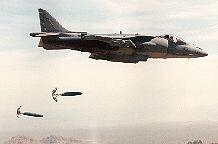AIR-TO-GROUND WEAPONS
Naval Aviation possesses numerous types of air-to-ground weapons, all
of which are designed for different targets, levels of accuracy, and lethality.
 CLOSE-IN WEAPONS
CLOSE-IN WEAPONS
Weapons such as the Mk-80 series General Purpose (GP) bomb family, Rockeye,
Gator, and 2.75" and 5" rockets are close-in, direct-attack, unguided munitions.
Close-in precision-guided munitions (PGMs), such as Laser-Guided Bombs
(LGBs), AGM-65 Mavericks, and Hellfire II improve weapon lethality via
increased accuracy.
Joint Direct Attack Munition
The Joint Direct Attack Munition (JDAM) currently under development is
a multi-service effort to develop a strap-on, GPS-aided Inertial Navigation
System (INS) guidance kit that will improve the accuracy of GP bombs in
all weather conditions. JDAM also will allow a single aircraft to attack
multiple targets from a single release point.
STAND-OFF WEAPONS
But Naval Aviation needs more than just close-in weapons. Point-defense
surface-to-air missiles comprise approximately 85 percent of the weapons
that make up enemy integrated air defense systems. Currently, Naval Aviation's
capability to attack targets from beyond the range of these systems is
limited to HARM, the Stand-off Land Attack Missile (SLAM), and the AGM-62
Walleye. These weapons acquire and home in on their targets using various
techniques, including passive homing on radar and radio emitters (HARM)
and electro-optics in the visible (Walleye) and infrared (SLAM) spectrums.
However, they provide limited adverse weather capability and only carry
a unitary warhead for attacks against point targets. HARM has shown great
flexibility and continues to be upgraded; the Navy is currently developing
Block V and VI modifications into the missile ‹ giving it the capability
to attack GPS jammers ‹ and adding an INS/GPS suite. Walleye, developed
in the 1960s, will be phased out of the inventory by 2005.
Joint Stand-off Weapon
A new family of Stand-off Outside Point Defense weapons will be introduced
to the fleet beginning in FY 1998-1999, beginning with the Joint Stand-Off
Weapon (JSOW). JSOW is another multi-service program that will replace
five types of the older air-to-ground weapons currently in the naval inventory.
It will provide a family of precision-guided weapons that will allow naval
aircraft to attack area as well as point targets at increased stand-off
distances, greatly increasing aircraft survivability. JSOW will be usable
in adverse weather conditions, and like JDAM, will give aircrews the ability
to attack multiple targets in a single sortie.
SLAM/SLAM-ER Expanded Response (ER)
 SLAM-ER is Naval Aviation's
follow on to the SLAM Stand-off Outside Area Defense weapon. It is a day/night,
adverse-weather, precision-strike weapon with over-the-horizon range. SLAM
is based on the highly successful and reliable Harpoon anti-ship missile,
with a GPS-aided INS system for mid-course guidance, and a Maverick Imaging
Infrared sensor and a Walleye data link for precise, "man-in-the-loop"
terminal guidance.
SLAM-ER is Naval Aviation's
follow on to the SLAM Stand-off Outside Area Defense weapon. It is a day/night,
adverse-weather, precision-strike weapon with over-the-horizon range. SLAM
is based on the highly successful and reliable Harpoon anti-ship missile,
with a GPS-aided INS system for mid-course guidance, and a Maverick Imaging
Infrared sensor and a Walleye data link for precise, "man-in-the-loop"
terminal guidance.
SLAM-ER is an evolutionary upgrade of SLAM, providing the Navy and Marine
Corps with a major improvement in precision strike capability. A modified
Tomahawk warhead improves lethality and penetration. New planar wings have
been added, doubling the range and allowing terrain following flight. Mission
planning time has been reduced to 30 minutes, and targeting has been improved
via a "freeze frame" command that also reduces pilot workload. SLAM-ER
has been approved for production and will be fielded in 1999.
SLAM-ER+ will also incorporate Advanced Terminal Guidance (ATG), making
it an autonomous weapon, and enhancing the missile's capability against
small targets and targets in urban environments. ATG uses a matching algorithm
to recognize both the target and the surrounding scene, eliminating the
need for a data link. SLAM-ER weapons fitted with ATG will be fielded in
the 1999-2000 timeframe.
 System
Overview
System
Overview  Safety
Safety  Affordable
Avionics
Affordable
Avionics  C4/ISR
C4/ISR  Aircraft
Carriers
Aircraft
Carriers  Carrier
Air Wings
Carrier
Air Wings
 F-14
Tomcat
F-14
Tomcat  F/A-18
Hornet
F/A-18
Hornet  Joint
Strike Fighter
Joint
Strike Fighter  Airborne
Reconnaissance Vision
Airborne
Reconnaissance Vision  E-2C
Hawkeye
E-2C
Hawkeye  S-3B
Viking
S-3B
Viking
 ES-3A
Shadow
ES-3A
Shadow  Common
Support Aircraft
Common
Support Aircraft  EA-6B
Prowler
EA-6B
Prowler  Helicopter
Master Plan
Helicopter
Master Plan
 Marine
Corps Fixed-Wing Aircraft
Marine
Corps Fixed-Wing Aircraft  Marine
Corps Rotary-Wing Aircraft
Marine
Corps Rotary-Wing Aircraft  P-3C
Orion
P-3C
Orion  EP-3E
Aries II
EP-3E
Aries II  E-6A/B
Mercury
E-6A/B
Mercury
 Air-to-Air
Missiles
Air-to-Air
Missiles  Air-to-Ground
Weapons
Air-to-Ground
Weapons  Air-to-Subsurface
Weapons
Air-to-Subsurface
Weapons  Naval
Reserve Aviation
Naval
Reserve Aviation  Logistics
Airlift
Logistics
Airlift
 Training
Aircraft
Training
Aircraft  Aircrew
Training
Aircrew
Training  Aviation
Specialized Skills Training
Aviation
Specialized Skills Training  Logistics
Logistics  Expeditionary
Airfields
Expeditionary
Airfields
 Air
Traffic Control
Air
Traffic Control  Ranges
and Airfields
Ranges
and Airfields


 CLOSE-IN WEAPONS
CLOSE-IN WEAPONS CLOSE-IN WEAPONS
CLOSE-IN WEAPONS SLAM-ER is Naval Aviation's
follow on to the SLAM Stand-off Outside Area Defense weapon. It is a day/night,
adverse-weather, precision-strike weapon with over-the-horizon range. SLAM
is based on the highly successful and reliable Harpoon anti-ship missile,
with a GPS-aided INS system for mid-course guidance, and a Maverick Imaging
Infrared sensor and a Walleye data link for precise, "man-in-the-loop"
terminal guidance.
SLAM-ER is Naval Aviation's
follow on to the SLAM Stand-off Outside Area Defense weapon. It is a day/night,
adverse-weather, precision-strike weapon with over-the-horizon range. SLAM
is based on the highly successful and reliable Harpoon anti-ship missile,
with a GPS-aided INS system for mid-course guidance, and a Maverick Imaging
Infrared sensor and a Walleye data link for precise, "man-in-the-loop"
terminal guidance.